Created
June 26, 2013 17:27
-
-
Save sweinberg/5869451 to your computer and use it in GitHub Desktop.
My second semester Geometry notes and final exam study guide.
This file contains bidirectional Unicode text that may be interpreted or compiled differently than what appears below. To review, open the file in an editor that reveals hidden Unicode characters.
Learn more about bidirectional Unicode characters
| #Geometry Notes Second Semester | |
| *** | |
| ##Area, Surface Area and Volume | |
| ###Circumference | |
| * Circumference is the linear distance around the outside of a circular object. | |
| * C = π • d or π • 2r. | |
| * d = diamater or (radius • 2) | |
| * r = radius | |
| ###Perimeter | |
| * Perimeter is the distance around a figure. | |
| * It is found by adding the lenghts of all the sides. | |
| * Finding perimeter on the coordinate plane may require the use of the distance formula: | |
|  | |
| ####Regular Polygon | |
| * A *regular polygon* is a polygon that is equiangular and equilateral. | |
| * A = ½ ap | |
| * a = Apothem is distance from the center of a polygon to one of its sides. | |
| * p = ns | |
| * n = number of sides | |
| * s = length of each side | |
| ###Area | |
| ####Regular Polygon | |
| * Area = ½ (p • a) | |
| * p = perimeter | |
| * a = apothem | |
| ####Square | |
| * Area of a square = a • a | |
| * a = length of side | |
| ####Triangle | |
| * Area of a triangle = ½ • b • h | |
| * b = base | |
| * h = vertical height | |
| ####Parallelogram | |
| * Area of a parallelogram = b • h | |
| * b = base | |
| * h = vertical height | |
| ####Trapezoid | |
| * Area of a trapezoid = ½ (a + b) • h | |
| * a = 1st base | |
| * b = 2nd base | |
| * h = vertical height | |
| ####Rectangle | |
| * Area of a rectangle = b • h | |
| * b = base | |
| * h = height | |
| ####Circle | |
| * Area of a circle = πr•r | |
| * r = radius | |
| * radius = diameter / 2 | |
| ###Prism | |
| * A *prism* is a polyhedron with two congruent, parallel faces, called *bases*. | |
| * The other faces are *lateral faces* | |
| * An *altitude* of a prism is a perpendicular segment that joins the planes of the basses. | |
| * The *height* of a prism is the length of an altitude. | |
| * In a *right prism*, the lateral faces are rectangles and a lateral edge is an altitude. | |
| * In a *oblique prism*, some or all of the lateral faces are nonrectangular. | |
| ####Lateral Area | |
| * Lateral area of a prism is the sum of the areas of all the lateral faces. | |
| * L.A. = ph | |
| * p = perimeter of the base | |
| * h = height of the prism | |
| ####Surface Area | |
| * Surface area of a prism is the sum of the lateral area and the area of the two bases. | |
| * S.A. = L.A. + 2B | |
| * B = area of the base | |
| ###Surface Area | |
| ####Pyramid | |
| * Surface Area = L.A. + B | |
| * B = base area | |
| * Lateral Area = ½ pl | |
| * p = perimeter of base | |
| * l = slant height | |
| ####Cones | |
| * A *cone* is a 3D figure with one circular base and one vertex. | |
| * Surface Area = L.A. + B | |
| * B = base area | |
| * Lateral Area = π • r • l | |
| * r = radius | |
| * l = slant height | |
| ####Sphere | |
| * Surface area = 4π (r • r) | |
| * r = radius | |
| ###Volume | |
| ####Prisms | |
| * Volume = A • L | |
| * A = area of base | |
| * L = length of prism | |
| ####Cylinders | |
| * Volume = π (r • r) h | |
| * r = radius of base circle | |
| * h = height of cylinder | |
| ####Pyramids | |
| * Volume = 1/3 (Ah) | |
| * A = area of base | |
| * h = height | |
| ####Square Pyramids | |
| * Volume = 1/3 (l • l) h | |
| * l = length of side of base | |
| * h = height | |
| ####Cones | |
| * Volume = 1/3 π (r • r) h | |
| * r = radius | |
| * h = height | |
| ####Sphere | |
| * Volume = 4/3 π (r • r • r) | |
| * r = radius | |
| *** | |
| ##Triangles | |
| ###Types of Triangles | |
| ####45 - 45 - 90 Triangle | |
| * The height and base of a 45 - 45 - 90 Triangle are equal. | |
| * The hypotanuse is the height or base multiplied by radical 2. | |
| ####30 - 60 - 90 Triangle | |
| * The side across from the 30 degree angle is x. | |
| * The hypotanuse is 2x. | |
| * The side across from the 60 degree angle is x multiplied by radical 3. | |
| ####Isosceles Triangles | |
| An Isosceles ∆ is a ∆ with at least 2 congruent sides. | |
| #####Isosceles Triangle Theorem | |
| If two sides of a triangle are congruent, then the angles opposite to those sides are congruent. | |
| #####Converse of Isosceles Triangle Theorem | |
| If two angles of a triangle are congruent, then the sides opposite to the angles are congruent. | |
| ####Equilateral Triangles | |
| An Equilateral ∆ is a ∆ in which all three sides are equal. | |
| All three internal angles are also congruent to each other and are each 60°. | |
| ####Scalene Triangles | |
| A Scalene ∆ is a ∆ in which all sides are not equal. | |
| ###Congruency Postulates & Theorems | |
| ####SSS Postulate | |
| If three sides of one triangle are congruent to three sides of another triangle, then these two triangles are congruent. | |
| 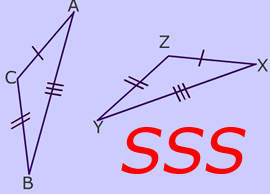 | |
| ####SAS Postulate | |
| If two sides and the included angle of one triangle are congruent to two sides and the included angle of another triangle, then these two triangles are congruent. | |
|  | |
| ####ASA Postulate | |
| If two angles and the included side of one triangle are congruent to two angles and the included side of another triangle, then these two triangles are congruent. | |
| 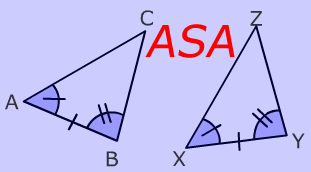 | |
| ####AAS Postulate | |
| If two angles and the non-included side one triangle are congruent to two angles and the non-included angle of another triangle, then these two triangles are congruent. | |
| 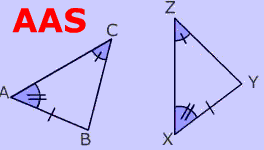 | |
| ####AA Similarity Postulate | |
| If two angles of one triangle are equal to two corresponding angles of another triangle, the two triangles are similar. | |
|  | |
| ####SSS Similarity Theorem | |
| If three pairs of corresponding sides are proportional, then the two triangles are similar. | |
|  | |
| ####SAS Similarity Theorem | |
| If two sides and the included angle of one triangle are in the same ratio as the corresponding two sides and included angle in another triangle, then the triangles are similar. | |
| 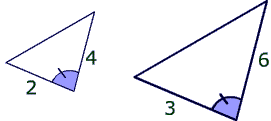 | |
| ####Hypotenuse-Leg Theorem | |
| If the hypotenuse and a leg of one right triangle are congruent to the hypotenuse and a leg of another right triangle, then the triangles are congruent. | |
| 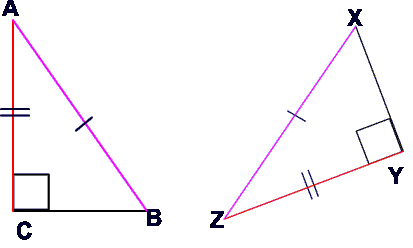 | |
| ####Corresponding Parts Theorem | |
| In congruent ∆'s, all corresponding sides and ∠'s are congruent. Once you conclude that a pair of ∆'s is congruent, their corresponding parts can be used to prove other ∆'s congruence. | |
|  | |
| ####Triangle Midsegment Theorem | |
| A midsegment of a triangle is a segment that connects the midpoints of two sides of a triangle. A midsegment connecting two sides of a triangle is parallel to the third side and is half as long. | |
|  | |
| ####Perpendicular Bisector Theorem | |
| A *perpendicular bisector* is a perpendicular line or a segment that passes through the midpoint of a line. | |
|  | |
| If a point lies on the perpendicular bisector of a segment, it is equidistant from the endpoints. | |
|  | |
| ####Angle Bisector Theorem | |
| An *angle bisector* is a line that bisects an interior angle, cutting it into two congruent halves. | |
| If a point is on the bisector of an angle, then the point is equidistant from the sides of the angle. | |
|  | |
| ####Angle-Side Correlation Theorem | |
| If two angles of a triangle are not congruent, then the longer side lies opposite to the larger angle, and vice versa. | |
|  | |
| ####Triangle-Angle-Bisector Theorem | |
| An angle bisector of an angle of a triangle divides the opposite side in two segments that are proportional to the other two sides of the triangle. | |
|  | |
| ####Side Splitter Theorem | |
| If a line is parallel to one side of a triangle and it intersects the other two sides, it divides those two sides proportionally. | |
|  | |
| ###Concurrent Lines | |
| Three or more lines that intersect at the same point. The point where they meet is called the *point of concurrency*. | |
| In an equilateral triangle, all four of the following triangle centers occur at the same point. | |
| ####Incenter | |
| Point of concurrency located at intersection of the angle bisectors. | |
|  | |
| ####Circumcenter | |
| Point of concurrency located at intersection of the perpendicular bisectors of the sides. | |
|  | |
| ####Centroid | |
| Point of concurrency located at intersection of medians. | |
|  | |
| ####Orthocenter | |
| Point of concurrency located at intersection of the altitudes of the triangle. | |
|  | |
| ###Parts of a Triangle | |
| ####Median | |
| A *median of a triangle* is a line segment from a vertex of the triangle to the midpoint of the side opposite that vertex. | |
|  | |
| ####Altitude | |
| An *altitude of a triangle* is a perpendicular segment from a vertex to the line containing the opposite side. | |
| If the triangle is a right triangle, the altitude can be one of the legs of the triangle. The altitude can even lie outside the triangle. | |
| The length of the altitude of a right triangle from the hypotenuse to the right angle, where the altitude is perpendicular to the hypotenuse, is the geometric mean of the two segments into which the hypotenuse is divided. | |
|  | |
| ####Legs and Hypotenuse | |
| The *legs* are the two shorter sides of a right triangle, and are perpendicular to each other. | |
|  | |
| The *hypotenuse* is the one longest side of a right triangle. The hypotenuse can be found using the pythagorean theorem: | |
|  | |
| ####Angle of Elevation | |
| An angle of elevation is the angle from the horizontal to a line of sight. | |
|  | |
| ####Angle of Depression | |
| An angle of depression is the angle from the horizontal down to a line of sight. | |
|  | |
| ###Trigonometry | |
| ####Soh Cah Toa | |
| * **S**in = **o**pposite / **h**ypotonuse. | |
| * **C**os = **a**djacent / **h**ypotonuse. | |
| * **T**an = **o**pposite / **a**djacent. | |
| 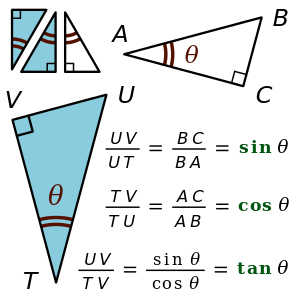 | |
| **Never use a 90 degree angle when dealing with Sin, Cos, or Tan.** | |
| *** | |
| ##Logic | |
| ####Inductive Reasoning | |
| *Inductive reasoning* is the process of using a series of observations to draw a general conclusion. | |
| ####Deductive Reasoning | |
| *Deductive reasoning* is the process of reasoning is logical steps from given statements or facts to reach a conclusion. | |
| ####Conjectures | |
| A *conjecture* is a conclusion reached by using inductive reasoning. Not all conjectures are true. | |
| ####Counterexamples | |
| A *counterexample* is an example for which a conjecture is incorrect. | |
| ####Conditional Statements | |
| An if-then statement is called a *conditional*. | |
| A conditional has two parts: If (hypothethis), then (conclusion). | |
| A conditional is **true** if the conclusion is always true whenever the hyptothethis is true. | |
| A conditional is **false** if there exists even one counterexample for which the conclusion is falce when the hypothesis is true. | |
| ####Converses | |
| The *converse* of a conditional switches the hypothesis and the conclusion. | |
| ####Biconditionals | |
| When a conditional and its converse are true, they can be combined into a *biconditional*. | |
| A biconditional is a statement containing "if and only if." | |
| Both the original conditional and its converse are true. | |
| Conditional: If *x*, then *y*. | |
| Converse: If *y*, then *x*. | |
| Biconditional: *X* if and only if *y*. | |
| ####Definitions | |
| A definition is a statement that can help you identify or classify an object. | |
| A good definition: | |
| * uses clearly understood terms. | |
| * is precise. | |
| * can be written as a biconditional. | |
| ####Law of Detachment | |
| In the first form of deductive reasoning, the *Law of Detachment*, a single conditional statement is made, and a hypothesis is stated. The conclusion is then deduced from the statement and the hypothesis. | |
| ####Law of Syllogism | |
| The second form of deductive reasoning, the *Law of Syllogism*, takes two conditional statements and forms a conclusion by combining the hypothesis of one statement with the conclusion of another. | |
| ####Indirect Proof | |
| * State an assumption opposite of what you want to prove. | |
| * Show that this assumption leads to a contradiction. | |
| * Conclude that the assumption must be false and that what you want to prove must be true. |
Sign up for free
to join this conversation on GitHub.
Already have an account?
Sign in to comment